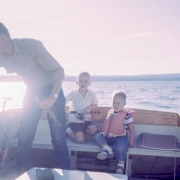Strategies for Breaking Up, Part 2 | Healthy Aging Series: Season 9, Episode 9
Breaking Up with Food by Using Self-Binding Strategies
“Dopamine Nation: Finding Balance in an Age of Indulgence,” by Anna Lembke
My wife and I love to use bed and breakfasts when we travel. We stayed in one called Cactus Cove in Tucson on one of our recent trips. We had a desert view of the Catalina mountains and Saguaro Cacti and visited the Biosphere. Pretty cool. Tucson also has great restaurants.
Prohibition
Prior to the Pandemic, we stayed in a beautiful bed and breakfast outside Berea, Kentucky that was an old farmhouse built with a wonderful view of an open meadow. On our way to Berea, I noticed the Boone Tavern. We wanted to wake up the next morning, explore, and then finish it with a pint of beer at the tavern. While visiting a pottery shop on the outskirts of Berea, I asked the owner if there were any cool pubs near Berea College. He looked at me and smiled and then said that the county, which included Berea, was a dry county. It didn’t ruin my trip, but needless-to-say I was a little disappointed. By the way, the bed and breakfast had complementary drinks that had been donated by past guests.
Blue Laws
In Louisville, you can’t buy alcohol at liquor stores until 1 pm on Sundays. Having said that, you can order a drink with your brunch on Sunday after 10 am. It seems silly. At the worst, it’s inconvenient, which is exactly what these laws are meant to do.
These laws are social binders. They are barriers to buying alcohol.
Breaking up with Food Using Self-Binding Strategies
This season is about breaking up with food. This blog is about Self Binding as introduced in Anna Lembke’s book, “Dopamine Nation: Finding Balance in an Age of Indulgence.” She describes Self-Binding as “willfully and intentionally creating barriers between ourselves and our drug of choice in order to mitigate compulsive over consumption.”
Lembke goes on to describe three types of self-binding.
- Temporal Self-Binding or Time self-binding.
- Spatial Self-Binding.
- Categorical Self-Binding.
- I’ve added one or teased out the categorical type to include:
Social Self-Binding.
I’m going to expand on these as they relate to breaking up with food.
Self-Binding Strategies
1. Temporal Self-Binding (TSB).
TSB means using time limits and finish lines. Time-Restricted Eating or what some referred to as Intermittent Fasting is the use of time limits. You pick an eating window. Let’s say eight hours. You can fast from 8 pm until noon the next day. You break your fast at noon. Of course, you can’t over consume during your eating window, but limiting your eating window is a way of intentionally putting up a barrier to overconsumption.
On most weeks, I use this strategy 2 to 3 times a week. By limiting my eating window, and engaging in exercise activity during the fast, I create a calorie deficit, which helps maintain a healthy weight. There isn’t really anything magical about fasting, except that it tends to decrease your caloric intake throughout the day. The Whole 30 Diet is another example of TSB. You limit your intake of foods like sugar, grains, dairy products, and alcohol for 30 days.
Many of you have been following this blog, and some of my blogs have shared my reflections from Obesity Memoirs. One of the constant variables in these memoirs is eat less/move more. Time-Restricted Eating is a Temporal Self-Binding procedure that helps you eat less.
You can use Temporal Self Binding to limit sweets to only weekends or special occasions. There are some that limit alcohol consumption to 25 or maybe 50 times a year. That would be 2 to 3 times a month. Temporal Self-Binding means structuring your day by putting up barriers that make access to food more difficult. During the pandemic, a therapist friend told me that she decided to only drink alcohol on the weekends. She noticed that she was drinking more because she was home all the time. Temporal Self-Binding is necessary because willpower is unreliable.
2. Spatial Self-Binding (SSB).
Here we are talking about rearranging your space by limiting where we go, limiting what we have in your cabinets, and creating an environment where food is not center stage. I use SSB by not bringing in foods, like sugars and sweets into my home. I try avoiding Panera in the mornings. It also means that I have a healthy snack food in the fridge or cabinet that limits my ability to overconsume. SSB means staying out of the process-food section of the grocery store, you know, the center section.
SSB involves looking at your home, your car, your neighborhood, the route you take to work, your office, where you shop for clothes, where you eat out, where you stop for coffee, and then come up with a plan for making it difficult to relapse back into over consuming and into a dysfunctional relationship with food.
Imagine breaking up with a partner you spent lots of time with hanging out at Sunergos Coffee. It was a tough break up. One of those “I love you, but we aren’t good for each other” break ups, like the kind of relationship you have with food. I think you’re going to want to do some Spatial Self-Binding by finding another coffee shop to avoid running into “you know who.”
Spatial Self-Binding means finding new places to hang out and avoiding the places where you overconsume.
3. Categorical Self-Binding (CSB).
CSB means finding things or categories of things to replace the food that you’ve broke up with. For me, I need to replace sugar, alcohol, and bread. Those are the demons that I want to excise out of my life. So, I need replacements. Some replacement categories include real foods that will help you feel more satiated and more activity that is incompatible with eating processed food.
I remember working with an adult with an intellectual disability who was constantly annoying his housemate. Nothing seemed to decrease that until I asked the staff at his residence “What is he doing when he’s not annoying his housemate?“ They came up with a list of about 20 activities. I said, “Keep him busy doing these things. Offer him a menu of activities.” The behavior stopped immediately. He was too busy, enjoying his life to annoy his housemates.
Ask yourself, what am I doing when I am not overconsuming processed foods like sugar, bread, pastries.
CSB means adding things and structuring things into your life that make it nearly impossible to engage in consuming highly processed food.
In my jeep, I have squeeze fruits that include vegetables and proteins. There is no junk food or fast food in my Jeep. Nuts and dried fruits, that’s it.
I like writing in the evenings. That’s what I’m doing right now instead of eating processed food. It’s silly, but I try to avoid food-shows in the evening.
When willpower is low during the evenings or over the weekends after a grueling week, CSB will make it more difficult to consume, or overconsume foods that I’m trying to avoid.
Lembke stops with three, but I’ve added:
4. Social Self-Binding (SoSB).
SoSB involves the people in your life that affect your breakup with food.
People can affect you in many ways. They can affect you by inspiring you to grow and inspiring you to overcome your addiction. People affect you by being the reason you need to start or stay with your recovery from drugs or food. The love that people show you can help create an inner self-love which fuels your recovery. The people in your life can also weigh you down, affect your moods in negative ways, and can cause you to have an “I don’t give a shit“ attitude about your life and about life in general. And they can also cause a relapse in your recovery. SoSB involves managing the relationships in your life and assessing the influence they have as you attempt to break up with food. Unlike Spatial Self-Binding, where are you simply avoid the places where you overconsume, you can’t always avoid the people in your life that are catalyst for overeating, overdrinking, or overconsuming.
Social Self-Binding is a tool. It’s not a hammer that we used to break things up but maybe a sieve that allows you to sort out your relationships into more purposeful or intentional encounters.
The barriers that you create with Social Self-Binding are there, but more permeable than the other Self-Binding procedures. You let people in, partly, but you know their influence, and you prepare for letting them in.
Before letting them in, you practice letting them in. You practice your encounter. You rehearse your connections with people. People are complicated. At times they help, and at times they disrupt your plans. Seek out the helpers.
Prevention
These are the Self-Binding Principles for helping you break up and stay broken up with food. They are very behavioral and strategies that you typically set up before you encounter food.
Self-Binding is a tool, along with the other strategies, that I’ve presented in this blog.
I’ve read several Obesity Memoirs, and I’ll share some of the Self-Binding principles that they used on their journey to lose weight and break up with food.













